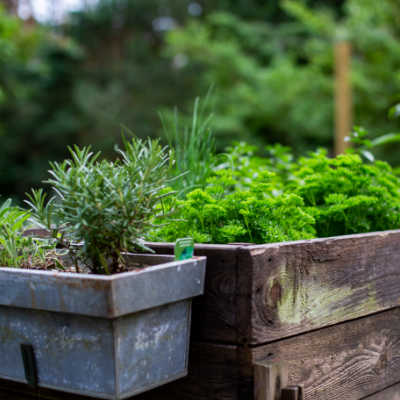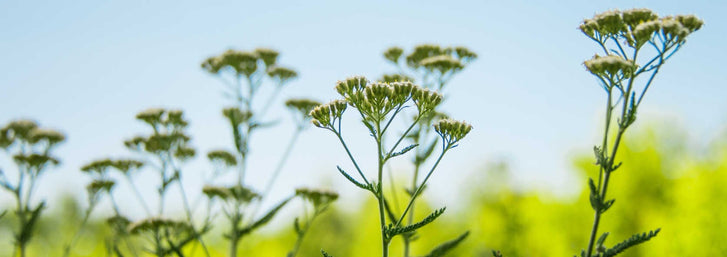
Ashleigh Smith

Originally Published Nov 24, 2021
Updated Feb 20, 2023
It's that time of year again, and I love planning a new garden! If you have grown a garden in the past, start by evaluating what went well and what you would like to do differently. Build on your previous year's knowledge by adding more vegetables and flowers, or using more complicated practices like companion planting and crop rotation.
New to gardening?
Start by considering why you are growing a garden. Is it to provide food for you and your family all year long? Do you just want some fresh fruits and vegetables for the summer? Do you want a fall harvest? Knowing what you want to get out of the garden will help you to know what to start with. Follow the steps outlined below to make your ideal garden plans.
How To Plan A Vegetable Garden
Step 1: Soil Testing
If you are growing with old raised beds or an in-ground plot, soil testing is recommended. Container gardens or new raised beds with new soil should simply have a seasonal home garden fertilizer of your choosing added. This will provide the needed nutrients over the growing season for healthy plant and fruit development. We recommend adding Minute Soil+ Coconut Coir to your raised bed or container gardens as it has already been amended with the necessary nutrients for a single growing season.
Testing your soil is easy and beneficial as you will get a report detailing the health of your soils with fertilizer recommendations. Growing in the same soil year after year can cause an imbalance of nutrients, organic matter, and pH. The testing process includes collecting a small amount of soil throughout your growing location, mixing each collection together, and mailing a sample of about 2 cups along with the form and necessary payment to your local agricultural college.

Each state has a designated land-grant university capable of testing soil samples. You can find the appropriate instructions and form on their website. Many universities will offer a variety of tests. You should look for a basic or routine test that will provide the necessary information for a home garden. If you have observed problems with plant leaves yellowing or dropping prematurely, we recommend getting a test that includes the routine points of interest plus a micronutrient assessment.
Step 2: List Vegetables, Herbs, and Flowers
This is the fun part! Create a list of all the vegetables, herbs, and flowers you would like to include in this years garden. Be sure to start with your favorites. Then, add on any others that fulfill the purpose of your garden, such as food preservation and storage, regular harvesting, or seasonal harvests. Growing a combination of vegetables, herbs, and flowers is recommended for organic pest control and better growth throughout the season. This practice is called companion planting. Flowers and herbs should be dispersed throughout the garden, rather than separated into their own sections.

Step 3: Sketch the growing Area

Once you have a list of plants you would like to grow, draw out your growing area. This drawing will be used to diagram your garden and collect more information. If you are growing a container garden you should sketch the area where your containers will be located, such as a patio or balcony. While no fancy computer programs are needed, I do find a piece of graph paper to be helpful in maintaining proportions and approximate measurements. This sketch shouldn’t include any plant placements yet.
Step 4: Sun-Map the Garden Location
Using your sketch keep track of what your sunlight is like throughout the day. Keep in mind the days will continue to get longer as spring and summer are approached. While the hours of sunlight in a day will change, your sun map will give you a good idea of which parts have shade, full, or partial sunlight. Full sun is considered 6 or more hours of light. Partial sun is 4-6 hours of direct sunlight. Afternoon light is typically hotter and more harsh on partial sun plants. Morning light can allow partial sun plants the necessary light without causing them to become scortched. Make note of any nearby trees that may affect the light reaching your garden once their leaves fill in.

Sun mapping is most accurate when done throughout the growing season. An estimate is okay for most scenarios, but we recommend taking the time to observe your whole yard periodically throughou your first growing season. This information can help you make plant decisions for seasons to come as you are familiar with how the sun shines throughout your property and against each side of your home.
Step 5: Draft Your Garden Plans
Now that you know approximately how many hours of light each part of your garden receives, it is time to create your planting map. Using the approximate measurements of each plant at maturity, draft their placement. Keep in mind the support or trellising needs of specific plants. You will want to support them while still being able to access them for harvesting. Start by placing your vegetables
For the convenience of rotating crops each year, I suggest planting by their family groups. This will help prevent pest infestations from arrising or carrying over year to year. Many pests can overwinter as larvae and emerge the following season. This growth cycle can be interrupted by crop rotations as specific pests tend to feed on specific plant families, ignoring the others. Some of the most common vegetables are listed in their appropriate families below.
- Allium - Chive, Garlic, Leek, Onion, Shallot
- Solanaceae - Eggplant, Tomato, Pepper, Potato, Tomatillo
- Brassicaceae - Broccoli, Cabbage, Cauliflower, Collards, Kale, Kohlrabi, Mustard, Radish, Rutabaga, and Turnip
- Cucurrbitaceae - Cucumbers, Gourds, Melon, Pumpkin, Squash
- Legume - Beans, Peas, Soybeans
- Apiaceae/Umbelliferae - Carrots, Dill, Fennel, Parsley, Parsnips
- Amaranthaceae - Swiss Chard, Spinach, Beets

As for herbs and flowers, disperse them throughout the garden. I like utilizing containers and pots for herbs and flowers as they can be helpful in containing herbs like mint that like to take as much space as they can. Containers can also be useful in changing flowers seasonally for unique color combinations or blooms all season long.
Step 6: Schedule Planting and Expected Harvest Dates
With a visual plan ready, you can now select the specific plant varieties you would like to use. I highly recommend using a planner or notebook to keep track of each seed or plant you will grow. Record the variety name and plant type, number of plants or seeds you intend to grow, and the days to maturity (specify if this is from transplant or direct sowing). Note if a seed needs to be started indoors ahead of time, along with how many weeks it needs before transplanting.
You should also take note of your last spring frost and first fall frost dates. These can be found most accurately through a local weather tracker, although they are available as approximations by zone in this chart. With this information gathered, I like to create a spreadsheet that allows me to organize all of the plants by their planting date, garden plot, or plant type. As you become more comfortable with creating gardens each year, you will find a system that is ideal for you.

Step 7: Amend Soil According to Soil Test Results
Before planting, it is important to prepare the soil. You can have the prettiest designs, best seeds, and the most ideal weather, but without good soil your garden will not thrive. Using the results of your soil test, work the necessary fertilizer and organic matter (amendments) into the soil. For those using long-term organic practices, we recommend utilizing cover crops to add vital nutrients and organic matter back into the soil. Just be sure to allow approximately 2-3 weeks after cutting the cover crop down before planting. The mowed cover crop will need time to start breaking down, otherwise it may tie up nutrients in the soil that you want available to your new plants.

Step 8: Transplant Starts or Direct Plant According to Schedule
Once your soil is prepared and your last spring frost date has passed, you can start planting outdoors. It is best to plant when the weather is reliably above 45-50°F. Otherwise, you will want to watch the weather and be sure to cover your young plants if night temperatures get close to freezing. Keep track of each sowing and transplanting in your garden journal or tracker. Make note of any irregularities you experience throughout the growing season. It can be helpful to make note of inclimate weather, rains, wind, frost, snow, heat waves, drought, fluctuating temperatures, etc. Each of these may affect the outcomes of your harvest and garden progress as a whole. Being able to look back at what has happened in the garden can also help you prepare for future growing seasons as you learn what works best for you and your area.

Be sure to check on your garden regularly. Walking through it daily to check for pests can save your garden from developing detrimental infestations. For help in spotting common garden pests, check out our pest guide. You can find images of each pest at various growth stages, treatment options, and other helpful information.
About the Author

I'm Ashleigh Smith, a native to Northern Utah. I first gained a love of gardening with my grandmother as I helped her each summer. I decided to make a career of it and have recently graduated with a Bachelor's degree in Horticulture from Brigham Young University - Idaho. My studies have focused on plant production while I also have experience in Nursery & Garden Center Operations.
Become a True Leaf Market Brand Ambassador! You’ll enjoy awesome perks, free products and exclusive swag & offers! Help us create a gardening revolution and help others experience the joy of growing!
Leave a comment
Your email address will not be published. Required fields are marked *
9 comments
Danielle RowLee
Great information! You brought things to my attention that I hadn’t thought about!
minh
can i plant tomato and eggplant in pot 5 gallons or bigger?
Rachel
Garden planning is one of my favorite times of the year. Trying my hand at companion planting this year.
Connie AKA Granny in the Garden
We do the Back to Eden We have never sent our soil to be tested We use the Old Farmer way with a qt Mason Jar if ya think bout Ph it can differ within a foot. If you want I can share the Mason Jar with ya ..Love your seed. PS. O ne has to follow the weather Farmer Almanac says we are 5b I always tell people I have never seen that farmer in my garden..LOL
Melanie Grooms
I have read that planting wildflowers throughout your garden can help keep your food protected as well. It is also beneficial to monarchs and pollinators.
Autumn Raduenz
I love planning out my garden and adding and adjusting what I grow based on how well it does in our area.
Alex
Can’t wait to finish planning my garden. Definitely learned from last year. Going be move my corn to give some of the veggies some shade. Making a list of what produce will be ready when will help me plan better.
Brandy
Great information! Thank you!
Alexis Robbins
This post is perfect timing! We are working on a homeschool co-op and church project, and it is from scratch- or should I say from the ground up. LOL. I’m definitely going to follow these steps. Thank you!
Further Reading

10 Natives of the Southwest USA for Pest Control
Written By Lara Wadsworth The Southwestern United States is a region incredibly unique to the rest of the country. The hot, dry weather can be challenging for plants and animals to thrive without additional help. That is why gardening with natives can ...

Ashleigh Smith
2024-04-157 min read0
Spring Into Action - Celebrating Earth Day
Written By Chelsea Hafer Spring is quickly arriving, and that means that Earth Day is near! Earth Day is the perfect occasion to appreciate our wonderful planet and all that it does for us and think of ways you can give back to it. In this blog post, w...

Ashleigh Smith
2024-04-154 min read0
Everything You Need To Know About Rain Gardens
Written By Lara Wadsworth Rain gardens are quickly gaining popularity for their perfect marriage of utility and beauty. What simply looks like a beautifully landscaped garden is actually a native habitat that serves as a storm drain and water sponge. B...

Ashleigh Smith
2024-04-085 min read1
Northeastern Natives for Attracting Beneficial Insects
Written By Lara Wadsworth The Northeastern United States is rich with American history, but did you also know that it is rich in plant biodiversity? Nature has learned through time how to work in harmony with the various species that attempt to thrive....

Ashleigh Smith
2024-04-086 min read1



